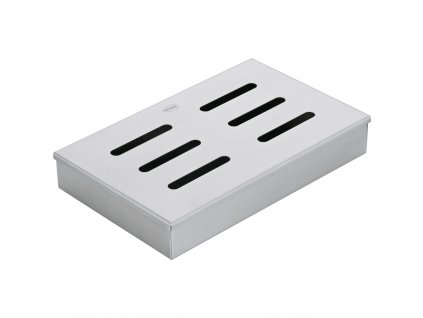Garden smokehouse
Garden smokehouse – smoked to perfection
A smokehouse is a dedicated outdoor structure designed for the purpose of smoking and preserving food. It's a place where various types of foods, particularly meats, fish, and vegetables, are exposed to controlled smoke and heat over an extended period. The process of smoking not only imparts unique flavours to the food but also helps in preserving it by drying and adding a layer of protection against spoilage.
Here are the key features and components of a typical garden smokehouse:
-
Structure: A smokehouse is typically a small, enclosed building or structure designed to accommodate the smoking process. It can vary in size from small backyard units to larger, more elaborate setups.
-
Smoking Chamber: The smoking chamber is the main compartment of the smokehouse where the food is placed for smoking. It's equipped with racks or hooks to hold the food items. The chamber should have proper ventilation to allow smoke circulation and temperature control.
-
Firebox or Smoke Generator: A smokehouse requires a heat source to generate smoke. This is often achieved using a firebox, charcoal, or an electric or propane-powered smoke generator. The heat source also helps maintain the desired temperature for smoking.
-
Ventilation: Adequate ventilation is essential to control the airflow within the smokehouse. Proper ventilation ensures that smoke circulates evenly around the food and prevents the accumulation of excessive heat or smoke.
-
Temperature Control: Maintaining consistent temperatures during the smoking process is crucial for achieving the desired results. Some smokehouses have built-in temperature control mechanisms, while others rely on manual adjustments to control the fire and smoke intensity.
-
Smoke Vent: Smoke generated from the heat source needs a way to exit the smoking chamber. A smoke vent or chimney allows excess smoke to escape while maintaining a controlled environment inside the chamber.
-
Wood Chips or Chunks: The choice of wood chips or chunks plays a significant role in determining the flavour profile of smoked food. Different woods impart distinct flavours, such as hickory, mesquite, applewood, cherry, and more.
-
Thermometer: Many smokehouses are equipped with thermometers to monitor the internal temperature of the smoking chamber. This helps ensure that the food is being smoked at the desired temperature range.
-
Racks or Hooks: Inside the smoking chamber, racks or hooks are used to hang or place the food items for smoking. Racks provide even exposure to smoke and heat, allowing for consistent results.
-
Drip Tray: Some smokehouses have drip trays to catch any drippings from the food during the smoking process. This helps keep the smoking chamber clean and prevents flare-ups.
-
Insulation: Insulation can help regulate the internal temperature of the smokehouse, making it more efficient and easier to maintain the desired smoking conditions.
Garden smokehouses are available in various designs, from traditional rustic structures to more modern and efficient units. Building or using a smokehouse requires knowledge of smoking techniques, food safety, and proper equipment to ensure that the smoked food is safe to consume and has the desired flavour and texture.
What are the benefits of having a smokehouse in your garden?
Having a smokehouse in your garden can offer several benefits, particularly if you enjoy cooking and experimenting with different culinary techniques. Here are some of the advantages:
-
Flavor Enhancement: Smoking foods imparts a unique and delicious flavour profile that is difficult to achieve through other cooking methods. The slow smoking process allows the flavours from the wood smoke to infuse into the food, enhancing its taste.
-
Preservation: Historically, smokehouses were used as a means of food preservation. The smoking process helps to dry and preserve foods, extending their shelf life without the need for refrigeration.
-
Variety of Foods: A smokehouse provides the opportunity to smoke a wide range of foods, including meats, poultry, fish, vegetables, cheeses, and even nuts. This versatility allows you to experiment with different flavours and textures.
-
Customization: You have control over the type of wood chips or chunks used for smoking, which can significantly influence the final flavour of the food. Different woods, such as hickory, mesquite, apple, or cherry, impart distinct flavours.
-
Healthy Cooking Method: Smoking is generally considered a healthier cooking method compared to frying or grilling, as it requires minimal added fats or oils. The slow cooking process can also help to render out excess fat from meats.
-
Culinary Creativity: Having a smokehouse encourages culinary experimentation. You can try different recipes, marinades, rubs, and smoking techniques to create unique dishes.
-
Outdoor Cooking Experience: Setting up a smokehouse in your garden provides an opportunity to enjoy outdoor cooking and gather with friends and family. It can be a focal point for social gatherings and backyard parties.
-
Self-Sufficiency: If you grow your own vegetables or raise your own animals, a smokehouse can be a way to utilize and preserve your harvest, reducing food waste and promoting self-sufficiency.
-
Traditional Appeal: A smokehouse can add a rustic and traditional aesthetic to your garden or outdoor space, enhancing its overall ambience.
-
Educational Value: If you're interested in the art of smoking and food preservation, having a smokehouse provides a hands-on learning experience. You can learn about different smoking techniques, wood types, and the science behind the process.
-
Personal Satisfaction: Successfully smoking your own food can be incredibly satisfying and rewarding. It allows you to take pride in creating flavorful dishes from scratch.
-
Gifts and Sharing: You can share your smoked creations with friends, family, and neighbours. Smoked foods can also make thoughtful and unique gifts for special occasions.
Keep in mind that setting up a smokehouse requires careful planning, proper equipment, and adherence to safety guidelines to ensure both the quality of the food and the safety of the cooking process.
If you don't feel like using a garden smokehouse, go for a charcoal or electric grill or fire pit.

